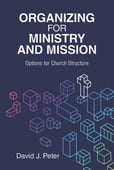The local congregation develops ministry efforts to accomplish God’s mandate. These initiatives intend to bring God’s gracious presence to people through His Word of the Gospel (Ephesians 1:3–14). They aim to deliver God’s power to release people from the bondage of sin and to enable sanctified living (Ephesians 1:15–2:10). They undertake to execute God’s plan of reconciliation (Ephesians 2:11–22). They seek to promote maturation of the saints (Ephesians 4:1–16). Such efforts, when aligned with these priorities, accomplish great and marvelous things in this world and for the world to come!
But the development and implementation of these ministry activities do not occur automatically and without effort. They require very intentional thinking and acting. Since they are done collaboratively, they require organization. Participation by multiple people in a shared effort will require some degree of organization. This is done so that the work of the Church is conducted effectively.
Read on to learn about three different organization models that may help your church accomplish God’s mandate.
Church Organization Model 1: The Working Board
The first option for congregational organization is the working board model. This is a more traditional approach to organization in that during the last half of the twentieth century it was the dominant model for structuring Protestant congregations. The track record reveals both success and frustrations resulting from the use of the model.
The working board model is so named because the members of a given board are expected to directly do the work that is the board’s responsibility—that is, the board members are working. They are directly engaged in the operational functions of the ministry focus of the board.
For example, under this model the members of the youth board plan the activities for the young people of the congregation and also execute those activities. They teach the teenagers on Sunday morning and coordinate the Wednesday-night gathering of young people. Youth board members serve as youth counselors who lead the occasional weekend retreat at a nearby camp. They sponsor and publicize the fund-raising events that the youth participate in. This board is actively involved in doing the work necessary to fulfill the youth ministry in the church. Its members are very “hands on” in terms of their involvement in the operations of the ministry.
Church Organization Model 2: The Managing Board
The second major type of organizational structure available for use by congregations, broadly speaking, is that of the managing board. This model is so named because the members of the board are expected to manage the work that is designated as the board’s responsibility but not to be directly active in the work. That is, the members of these boards do not do the work of ministry, but they see to it that it is done by others, while assisting those others when necessary.
The managing-board model is distinguished from that of the working board in the same way that supervising is distinguished from operating. When involved in operations, the elected members of the board personally perform the work that is assigned to the board; they do it. However, members of the managing board actively oversee the operations carried out by others; they see that it gets done. The difference is between directly doing (working board) and directing the doing (managing board).
This [model] can be applied to the coordinating lay council of a church, typically of a midsize congregation (150–400 average worship attendance) but sometimes of a small church or of a large one. The members of this council collaborate with the professional program staff, including the pastor. They actively manage the programmatic organization of the church by attending both to the strategic decision-making and to the operational matters of the programs. In managing the ministry of the congregation, the council members assume a hands-off/hands-on approach. That is, they delegate responsibilities to others but do not remain at a distance from those who are doing the work. Their hands are frequently involved in assisting in the operational work of their program areas. They “keep their hands on the wheel.”
Church Organization Model 3: The Governing Board
The third basic model of organizational structure is one that is becoming increasingly popular in churches today. Most of the books recently published on congregational structure follow this model. The model conforms to what James Galvin calls the governing board structure.
This [description] identifies the origin of this model of organization with John Carver, who laid out his design for board governance in his seminal book Boards That Make a Difference: A New Design for Leadership in Nonprofit and Public Organizations. In this work, Carver presents a comprehensive theory with prescribed principles and practices for how the fiduciary boards of corporations and nonprofit organizations should operate. This model has been called policy-based governance because it affirms that the essential work of a board is to
formulate policies that then are to be executed by a chief executive
officer (CEO) working through his staff.
The first thing to be noted about this model is that the elected board delegates responsibilities via policies to a CEO. Thus, when this model is applied to a Christian congregation, the assumption is that the pastor will function like a CEO. This may evoke a negative association among some Christians who envision a pastor acting as a powerful business executive, but this need not be the case. In many ways, the Carver model creates an arrangement in which the pastor is less authoritarian, not more so. This is because the pastor is expected to execute the will of the governing board that is composed of lay leaders who are elected by the voters assembly and charged to represent the best interests of the congregation.
Another assumption integral to this governance model is that the organization employs multiple paid staff members. It is for this reason that policy-based governance is becoming a dominant approach in large churches, which typically have numerous professional and paid staff. Multiple staff workers are also needed in midsize congregations, but the number of staff workers will be much fewer in the midsize parish as compared to the large one, so the utility of the Carver model is lessened.
 Learn more about the benefits of different church organization models in Organizing for Ministry and Mission: Options for Church Structure.
Learn more about the benefits of different church organization models in Organizing for Ministry and Mission: Options for Church Structure.
Blog post adapted from Organizing for Ministry and Mission © David J. Peter, published by Concordia Publishing House. All rights reserved.














